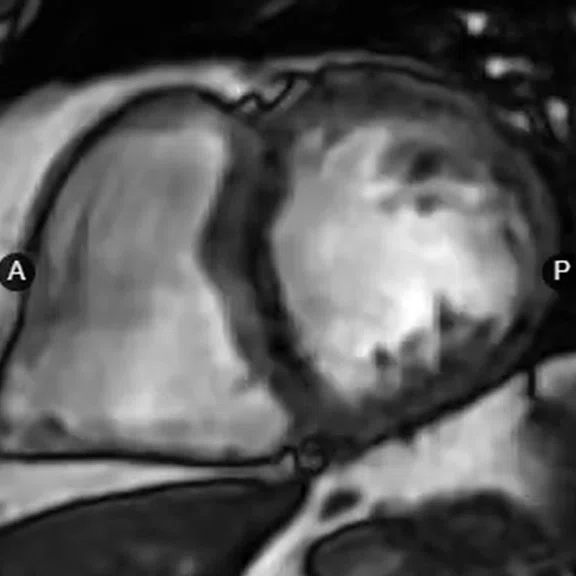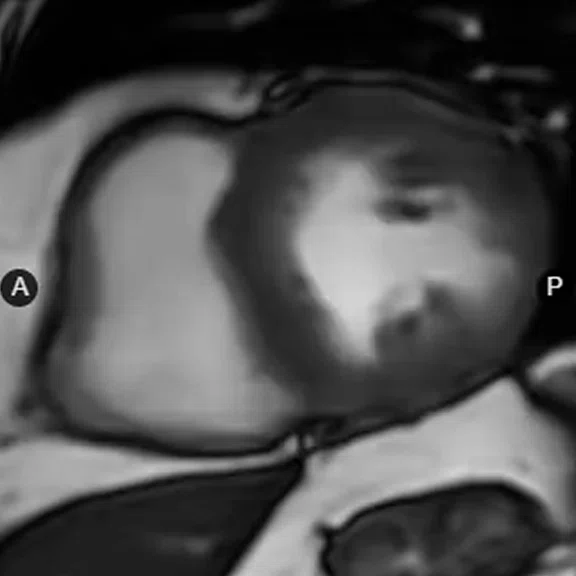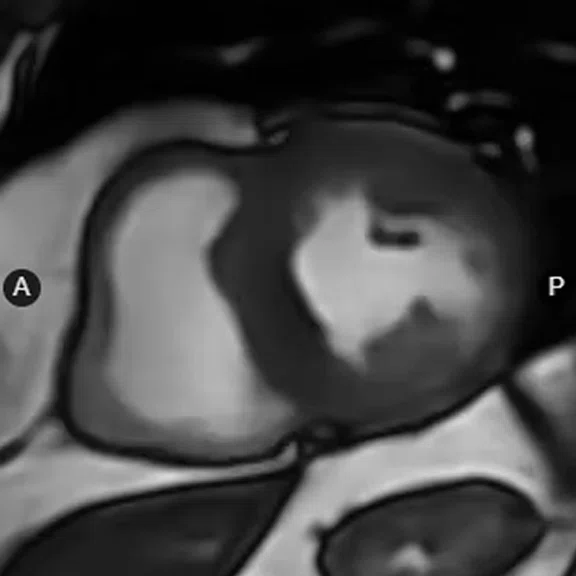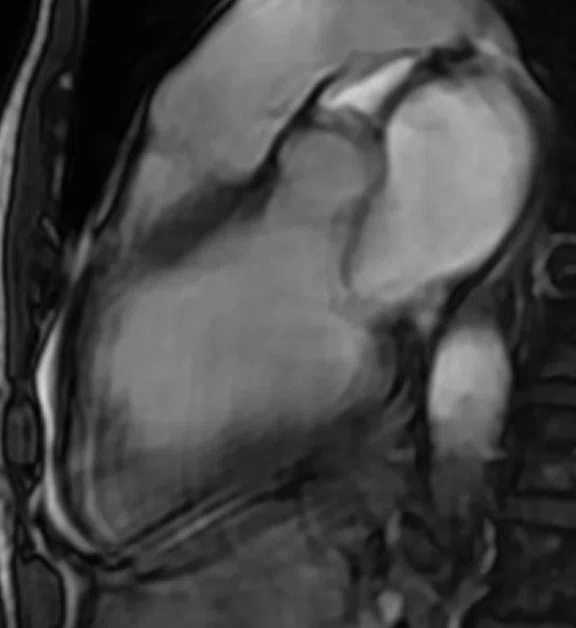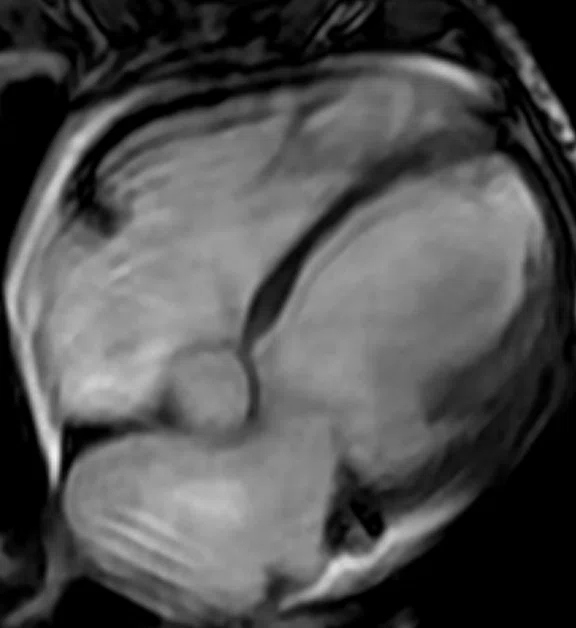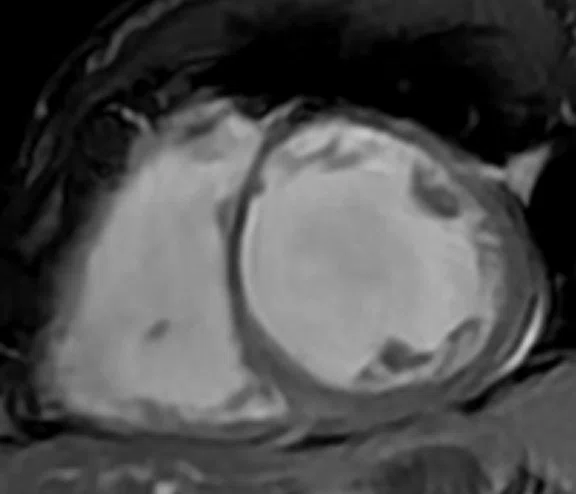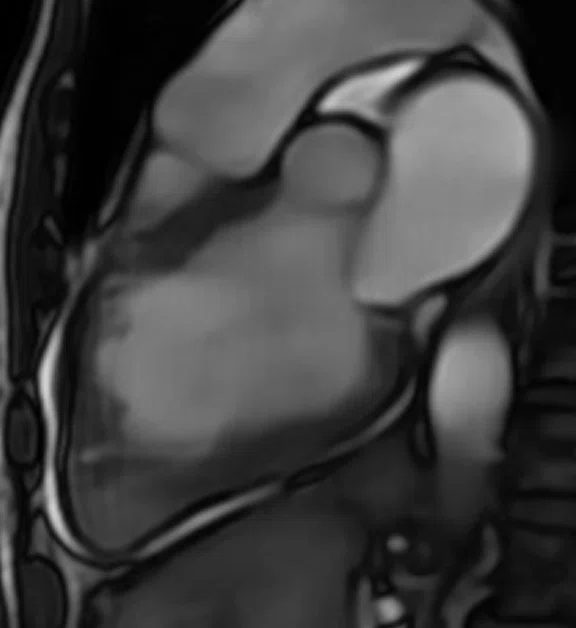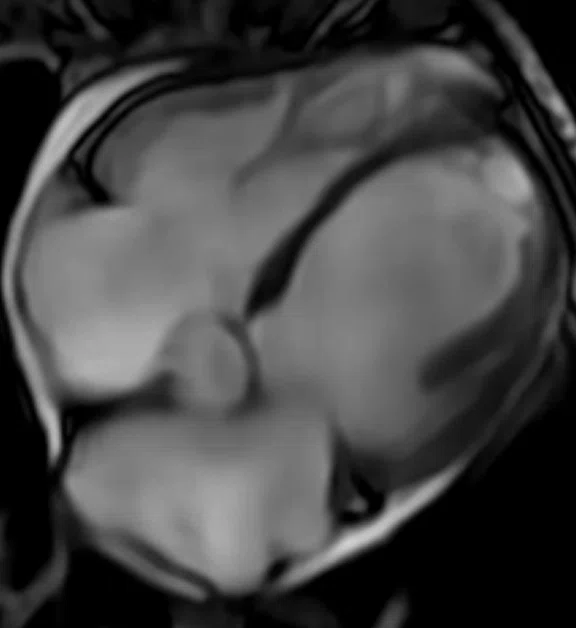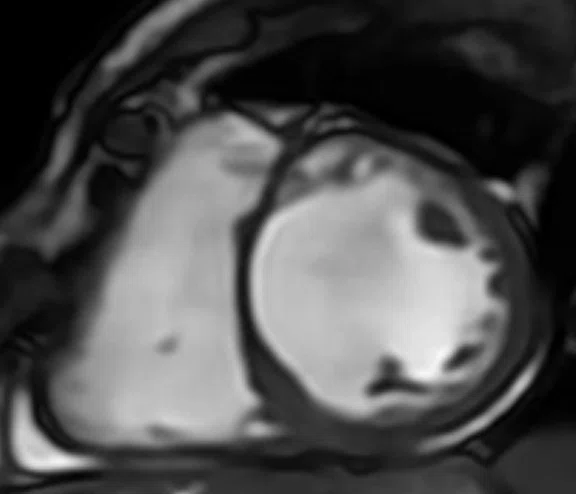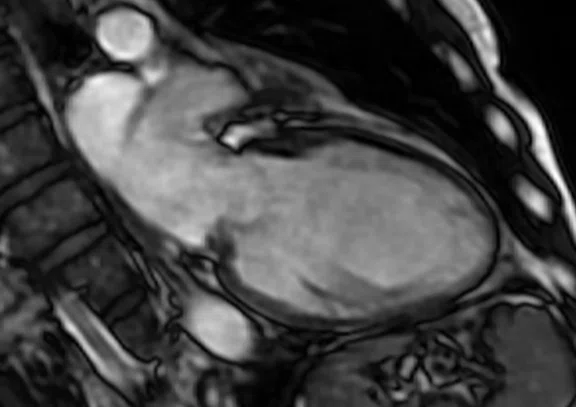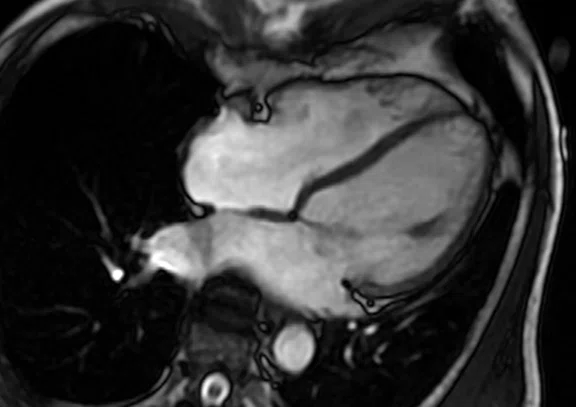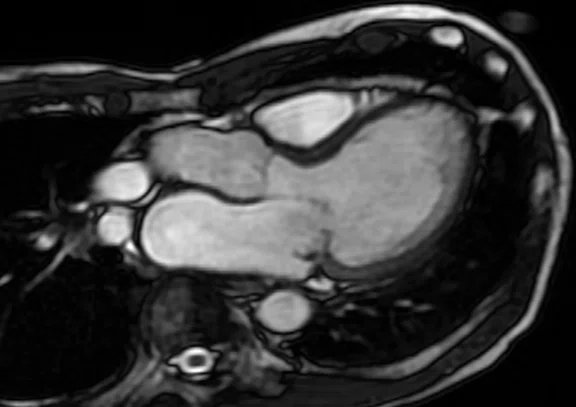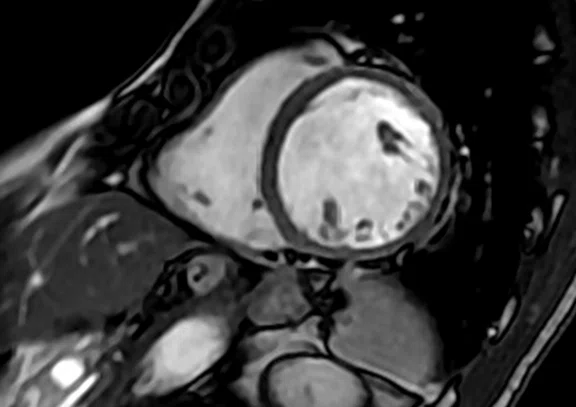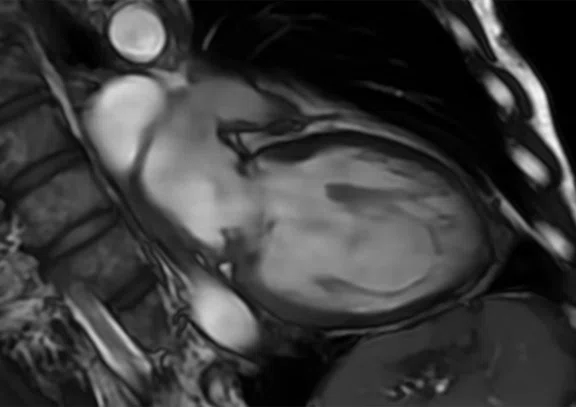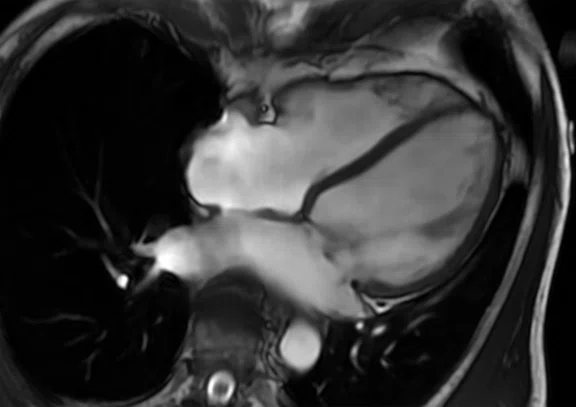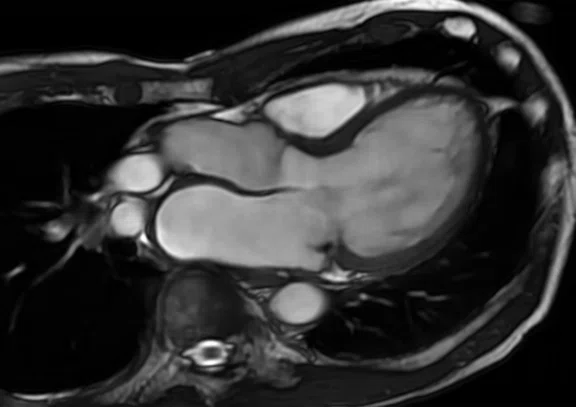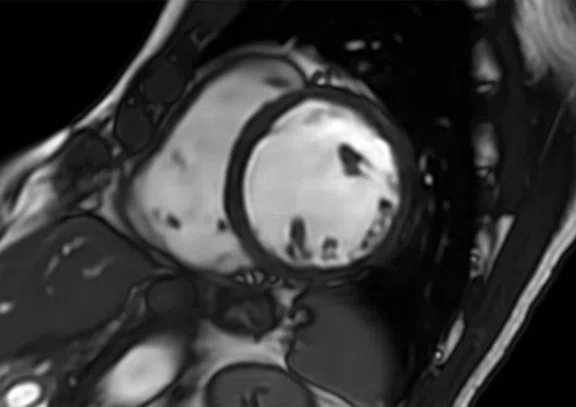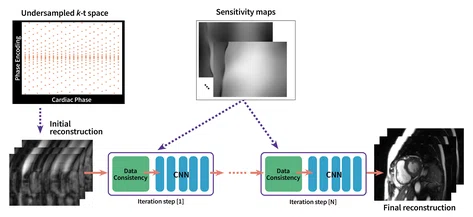A
Figure 1.
Acquisition on a 76-year-old patient with high premature ventricular contraction (PVC), one of the most challenging conditions to image in CMR, and shortness of breath. Comparison of (A) conventional FIESTA Cine, 1:46 min., (B) Sonic DL™ Cine 3 R-R, 40 sec., and (C) Sonic DL™ Cine 1 R-R, 21 sec. Even in patients with severe arrhythmia, Sonic DL™ Cine 3 R-R was unable to effectively manage the extra, abnormal heartbeats disrupting the normal rhythm characteristic of PVC©. As Sonic DL™ Cine 3 R-R is also a segmented technique, acceleration was increased to 12 to achieve 1 R-R, delivering (C) a real-time technique for obtaining good quality images, demonstrating the effectiveness of Sonic DL™ Cine acceleration. Images acquired on SIGNA™ Artist 1.5T, courtesy of Fairfax MRI Center, Fairfax, VA.
B
Figure 1.
Acquisition on a 76-year-old patient with high premature ventricular contraction (PVC), one of the most challenging conditions to image in CMR, and shortness of breath. Comparison of (A) conventional FIESTA Cine, 1:46 min., (B) Sonic DL™ Cine 3 R-R, 40 sec., and (C) Sonic DL™ Cine 1 R-R, 21 sec. Even in patients with severe arrhythmia, Sonic DL™ Cine 3 R-R was unable to effectively manage the extra, abnormal heartbeats disrupting the normal rhythm characteristic of PVC©. As Sonic DL™ Cine 3 R-R is also a segmented technique, acceleration was increased to 12 to achieve 1 R-R, delivering (C) a real-time technique for obtaining good quality images, demonstrating the effectiveness of Sonic DL™ Cine acceleration. Images acquired on SIGNA™ Artist 1.5T, courtesy of Fairfax MRI Center, Fairfax, VA.
C
Figure 1.
Acquisition on a 76-year-old patient with high premature ventricular contraction (PVC), one of the most challenging conditions to image in CMR, and shortness of breath. Comparison of (A) conventional FIESTA Cine, 1:46 min., (B) Sonic DL™ Cine 3 R-R, 40 sec., and (C) Sonic DL™ Cine 1 R-R, 21 sec. Even in patients with severe arrhythmia, Sonic DL™ Cine 3 R-R was unable to effectively manage the extra, abnormal heartbeats disrupting the normal rhythm characteristic of PVC©. As Sonic DL™ Cine 3 R-R is also a segmented technique, acceleration was increased to 12 to achieve 1 R-R, delivering (C) a real-time technique for obtaining good quality images, demonstrating the effectiveness of Sonic DL™ Cine acceleration. Images acquired on SIGNA™ Artist 1.5T, courtesy of Fairfax MRI Center, Fairfax, VA.
A
Figure 2.
Comparison of (A-C) conventional free-breathing, multi-averaging FIESTA Cine, 35 R-R per slice, no ASSET, temp. res.=45 ms, 8:15 min., and (D-F) free-breathing
Sonic DL™ Cine, 1 R-R per slice, acceleration 12, temp. res.=50 ms, 53 sec. Acquisition on a 85-year-old man with ischemic heart disease and a large ischemic sequelae in the left anterior descending artery. (A) FIESTA Cine 2-chamber, 52 sec., compared to (D) Sonic DL™ Cine 2-chamber, acceleration 12, 1 R-R, 3 sec. (B) FIESTA Cine 4-chamber, 52 sec., compared to (E) Sonic DL™ Cine 4-chamber, acceleration 12, 1 R-R, 3 sec. (C) FIESTA Cine short axis, 6:31 min., compared to (F) Sonic DL™ Cine short axis, acceleration 12, 1 R-R, 47 sec. Sonic DL™ Cine allows for an impressive 89% scan time reduction for full cardiac function assessment. Images acquired on SIGNA™ Voyager 1.5T, courtesy of Groupe de Mail, Grenoble, France.
B
Figure 2.
Comparison of (A-C) conventional free-breathing, multi-averaging FIESTA Cine, 35 R-R per slice, no ASSET, temp. res.=45 ms, 8:15 min., and (D-F) free-breathing
Sonic DL™ Cine, 1 R-R per slice, acceleration 12, temp. res.=50 ms, 53 sec. Acquisition on a 85-year-old man with ischemic heart disease and a large ischemic sequelae in the left anterior descending artery. (A) FIESTA Cine 2-chamber, 52 sec., compared to (D) Sonic DL™ Cine 2-chamber, acceleration 12, 1 R-R, 3 sec. (B) FIESTA Cine 4-chamber, 52 sec., compared to (E) Sonic DL™ Cine 4-chamber, acceleration 12, 1 R-R, 3 sec. (C) FIESTA Cine short axis, 6:31 min., compared to (F) Sonic DL™ Cine short axis, acceleration 12, 1 R-R, 47 sec. Sonic DL™ Cine allows for an impressive 89% scan time reduction for full cardiac function assessment. Images acquired on SIGNA™ Voyager 1.5T, courtesy of Groupe de Mail, Grenoble, France.
C
Figure 2.
Comparison of (A-C) conventional free-breathing, multi-averaging FIESTA Cine, 35 R-R per slice, no ASSET, temp. res.=45 ms, 8:15 min., and (D-F) free-breathing
Sonic DL™ Cine, 1 R-R per slice, acceleration 12, temp. res.=50 ms, 53 sec. Acquisition on a 85-year-old man with ischemic heart disease and a large ischemic sequelae in the left anterior descending artery. (A) FIESTA Cine 2-chamber, 52 sec., compared to (D) Sonic DL™ Cine 2-chamber, acceleration 12, 1 R-R, 3 sec. (B) FIESTA Cine 4-chamber, 52 sec., compared to (E) Sonic DL™ Cine 4-chamber, acceleration 12, 1 R-R, 3 sec. (C) FIESTA Cine short axis, 6:31 min., compared to (F) Sonic DL™ Cine short axis, acceleration 12, 1 R-R, 47 sec. Sonic DL™ Cine allows for an impressive 89% scan time reduction for full cardiac function assessment. Images acquired on SIGNA™ Voyager 1.5T, courtesy of Groupe de Mail, Grenoble, France.
D
Figure 2.
Comparison of (A-C) conventional free-breathing, multi-averaging FIESTA Cine, 35 R-R per slice, no ASSET, temp. res.=45 ms, 8:15 min., and (D-F) free-breathing
Sonic DL™ Cine, 1 R-R per slice, acceleration 12, temp. res.=50 ms, 53 sec. Acquisition on a 85-year-old man with ischemic heart disease and a large ischemic sequelae in the left anterior descending artery. (A) FIESTA Cine 2-chamber, 52 sec., compared to (D) Sonic DL™ Cine 2-chamber, acceleration 12, 1 R-R, 3 sec. (B) FIESTA Cine 4-chamber, 52 sec., compared to (E) Sonic DL™ Cine 4-chamber, acceleration 12, 1 R-R, 3 sec. (C) FIESTA Cine short axis, 6:31 min., compared to (F) Sonic DL™ Cine short axis, acceleration 12, 1 R-R, 47 sec. Sonic DL™ Cine allows for an impressive 89% scan time reduction for full cardiac function assessment. Images acquired on SIGNA™ Voyager 1.5T, courtesy of Groupe de Mail, Grenoble, France.
E
Figure 2.
Comparison of (A-C) conventional free-breathing, multi-averaging FIESTA Cine, 35 R-R per slice, no ASSET, temp. res.=45 ms, 8:15 min., and (D-F) free-breathing
Sonic DL™ Cine, 1 R-R per slice, acceleration 12, temp. res.=50 ms, 53 sec. Acquisition on a 85-year-old man with ischemic heart disease and a large ischemic sequelae in the left anterior descending artery. (A) FIESTA Cine 2-chamber, 52 sec., compared to (D) Sonic DL™ Cine 2-chamber, acceleration 12, 1 R-R, 3 sec. (B) FIESTA Cine 4-chamber, 52 sec., compared to (E) Sonic DL™ Cine 4-chamber, acceleration 12, 1 R-R, 3 sec. (C) FIESTA Cine short axis, 6:31 min., compared to (F) Sonic DL™ Cine short axis, acceleration 12, 1 R-R, 47 sec. Sonic DL™ Cine allows for an impressive 89% scan time reduction for full cardiac function assessment. Images acquired on SIGNA™ Voyager 1.5T, courtesy of Groupe de Mail, Grenoble, France.
F
Figure 2.
Comparison of (A-C) conventional free-breathing, multi-averaging FIESTA Cine, 35 R-R per slice, no ASSET, temp. res.=45 ms, 8:15 min., and (D-F) free-breathing
Sonic DL™ Cine, 1 R-R per slice, acceleration 12, temp. res.=50 ms, 53 sec. Acquisition on a 85-year-old man with ischemic heart disease and a large ischemic sequelae in the left anterior descending artery. (A) FIESTA Cine 2-chamber, 52 sec., compared to (D) Sonic DL™ Cine 2-chamber, acceleration 12, 1 R-R, 3 sec. (B) FIESTA Cine 4-chamber, 52 sec., compared to (E) Sonic DL™ Cine 4-chamber, acceleration 12, 1 R-R, 3 sec. (C) FIESTA Cine short axis, 6:31 min., compared to (F) Sonic DL™ Cine short axis, acceleration 12, 1 R-R, 47 sec. Sonic DL™ Cine allows for an impressive 89% scan time reduction for full cardiac function assessment. Images acquired on SIGNA™ Voyager 1.5T, courtesy of Groupe de Mail, Grenoble, France.
Figure 3.
Same patient as in Figure 2. Comparison of quantitative measurements on conventional free-breathing, multi-averaging FIESTA Cine, 35 R-R, no ASSET, and Sonic DL™ Cine, 1 R-R, acceleration 12. Despite an impressive 89% scan time reduction for full cardiac function assessment as shown in Figure 2, there is no significant difference in quantitative measurements of the ventricle, namely end-diastolic volume (EDV), end-systolic volume (ESV), stroke volume (SV), and ejection fraction (EF).
A
Figure 4.
Comparison of (A-D) conventional FIESTA Cine with (E-H) Sonic DL™ Cine on a 58-year-old man who underwent mitral valve reconstruction with severe mitral regurgitation. (A-C) FIESTA Cine images were acquired with 9 R-R, ASSET 2, temp. res.=57.6 ms and (D) 8 R-R, ASSET 2, temp. res.=57 ms compared to Sonic DL™ Cine (E-G) with acceleration of 6, 6 R-R, temp. res.=32.4 ms and (H) with acceleration of 7, 3 R-R, temp. res.=45 ms. Sonic DL™ Cine demonstrates improved SNR and enables more slices per breath hold by leveraging higher acceleration capabilities for faster scan times. The enhanced temporal resolution with Sonic DL™ Cine brings increased sharpness to the images as well as scan time reductions of (E-G) 30% and (H) 55%, and spatial resolution improvements of (E) 38%, (F-G) 33% and (H) 13%. Images acquired on SIGNA™ Artist 1.5T, courtesy of KH Köln Porz, Cologne, Germany.
B
Figure 4.
Comparison of (A-D) conventional FIESTA Cine with (E-H) Sonic DL™ Cine on a 58-year-old man who underwent mitral valve reconstruction with severe mitral regurgitation. (A-C) FIESTA Cine images were acquired with 9 R-R, ASSET 2, temp. res.=57.6 ms and (D) 8 R-R, ASSET 2, temp. res.=57 ms compared to Sonic DL™ Cine (E-G) with acceleration of 6, 6 R-R, temp. res.=32.4 ms and (H) with acceleration of 7, 3 R-R, temp. res.=45 ms. Sonic DL™ Cine demonstrates improved SNR and enables more slices per breath hold by leveraging higher acceleration capabilities for faster scan times. The enhanced temporal resolution with Sonic DL™ Cine brings increased sharpness to the images as well as scan time reductions of (E-G) 30% and (H) 55%, and spatial resolution improvements of (E) 38%, (F-G) 33% and (H) 13%. Images acquired on SIGNA™ Artist 1.5T, courtesy of KH Köln Porz, Cologne, Germany.
C
Figure 4.
Comparison of (A-D) conventional FIESTA Cine with (E-H) Sonic DL™ Cine on a 58-year-old man who underwent mitral valve reconstruction with severe mitral regurgitation. (A-C) FIESTA Cine images were acquired with 9 R-R, ASSET 2, temp. res.=57.6 ms and (D) 8 R-R, ASSET 2, temp. res.=57 ms compared to Sonic DL™ Cine (E-G) with acceleration of 6, 6 R-R, temp. res.=32.4 ms and (H) with acceleration of 7, 3 R-R, temp. res.=45 ms. Sonic DL™ Cine demonstrates improved SNR and enables more slices per breath hold by leveraging higher acceleration capabilities for faster scan times. The enhanced temporal resolution with Sonic DL™ Cine brings increased sharpness to the images as well as scan time reductions of (E-G) 30% and (H) 55%, and spatial resolution improvements of (E) 38%, (F-G) 33% and (H) 13%. Images acquired on SIGNA™ Artist 1.5T, courtesy of KH Köln Porz, Cologne, Germany.
D
Figure 4.
Comparison of (A-D) conventional FIESTA Cine with (E-H) Sonic DL™ Cine on a 58-year-old man who underwent mitral valve reconstruction with severe mitral regurgitation. (A-C) FIESTA Cine images were acquired with 9 R-R, ASSET 2, temp. res.=57.6 ms and (D) 8 R-R, ASSET 2, temp. res.=57 ms compared to Sonic DL™ Cine (E-G) with acceleration of 6, 6 R-R, temp. res.=32.4 ms and (H) with acceleration of 7, 3 R-R, temp. res.=45 ms. Sonic DL™ Cine demonstrates improved SNR and enables more slices per breath hold by leveraging higher acceleration capabilities for faster scan times. The enhanced temporal resolution with Sonic DL™ Cine brings increased sharpness to the images as well as scan time reductions of (E-G) 30% and (H) 55%, and spatial resolution improvements of (E) 38%, (F-G) 33% and (H) 13%. Images acquired on SIGNA™ Artist 1.5T, courtesy of KH Köln Porz, Cologne, Germany.
E
Figure 4.
Comparison of (A-D) conventional FIESTA Cine with (E-H) Sonic DL™ Cine on a 58-year-old man who underwent mitral valve reconstruction with severe mitral regurgitation. (A-C) FIESTA Cine images were acquired with 9 R-R, ASSET 2, temp. res.=57.6 ms and (D) 8 R-R, ASSET 2, temp. res.=57 ms compared to Sonic DL™ Cine (E-G) with acceleration of 6, 6 R-R, temp. res.=32.4 ms and (H) with acceleration of 7, 3 R-R, temp. res.=45 ms. Sonic DL™ Cine demonstrates improved SNR and enables more slices per breath hold by leveraging higher acceleration capabilities for faster scan times. The enhanced temporal resolution with Sonic DL™ Cine brings increased sharpness to the images as well as scan time reductions of (E-G) 30% and (H) 55%, and spatial resolution improvements of (E) 38%, (F-G) 33% and (H) 13%. Images acquired on SIGNA™ Artist 1.5T, courtesy of KH Köln Porz, Cologne, Germany.
F
Figure 4.
Comparison of (A-D) conventional FIESTA Cine with (E-H) Sonic DL™ Cine on a 58-year-old man who underwent mitral valve reconstruction with severe mitral regurgitation. (A-C) FIESTA Cine images were acquired with 9 R-R, ASSET 2, temp. res.=57.6 ms and (D) 8 R-R, ASSET 2, temp. res.=57 ms compared to Sonic DL™ Cine (E-G) with acceleration of 6, 6 R-R, temp. res.=32.4 ms and (H) with acceleration of 7, 3 R-R, temp. res.=45 ms. Sonic DL™ Cine demonstrates improved SNR and enables more slices per breath hold by leveraging higher acceleration capabilities for faster scan times. The enhanced temporal resolution with Sonic DL™ Cine brings increased sharpness to the images as well as scan time reductions of (E-G) 30% and (H) 55%, and spatial resolution improvements of (E) 38%, (F-G) 33% and (H) 13%. Images acquired on SIGNA™ Artist 1.5T, courtesy of KH Köln Porz, Cologne, Germany.
G
Figure 4.
Comparison of (A-D) conventional FIESTA Cine with (E-H) Sonic DL™ Cine on a 58-year-old man who underwent mitral valve reconstruction with severe mitral regurgitation. (A-C) FIESTA Cine images were acquired with 9 R-R, ASSET 2, temp. res.=57.6 ms and (D) 8 R-R, ASSET 2, temp. res.=57 ms compared to Sonic DL™ Cine (E-G) with acceleration of 6, 6 R-R, temp. res.=32.4 ms and (H) with acceleration of 7, 3 R-R, temp. res.=45 ms. Sonic DL™ Cine demonstrates improved SNR and enables more slices per breath hold by leveraging higher acceleration capabilities for faster scan times. The enhanced temporal resolution with Sonic DL™ Cine brings increased sharpness to the images as well as scan time reductions of (E-G) 30% and (H) 55%, and spatial resolution improvements of (E) 38%, (F-G) 33% and (H) 13%. Images acquired on SIGNA™ Artist 1.5T, courtesy of KH Köln Porz, Cologne, Germany.
H
Figure 4.
Comparison of (A-D) conventional FIESTA Cine with (E-H) Sonic DL™ Cine on a 58-year-old man who underwent mitral valve reconstruction with severe mitral regurgitation. (A-C) FIESTA Cine images were acquired with 9 R-R, ASSET 2, temp. res.=57.6 ms and (D) 8 R-R, ASSET 2, temp. res.=57 ms compared to Sonic DL™ Cine (E-G) with acceleration of 6, 6 R-R, temp. res.=32.4 ms and (H) with acceleration of 7, 3 R-R, temp. res.=45 ms. Sonic DL™ Cine demonstrates improved SNR and enables more slices per breath hold by leveraging higher acceleration capabilities for faster scan times. The enhanced temporal resolution with Sonic DL™ Cine brings increased sharpness to the images as well as scan time reductions of (E-G) 30% and (H) 55%, and spatial resolution improvements of (E) 38%, (F-G) 33% and (H) 13%. Images acquired on SIGNA™ Artist 1.5T, courtesy of KH Köln Porz, Cologne, Germany.
result
Subscribe Now
Manage Subscription
FOLLOW US
contact us • privacy policy • terms & conditions
© 2024 GENERAL ELECTRIC Company


Tech Trends
How Sonic DL Cine expands patient access to cardiac MR
How Sonic DL Cine expands patient access to cardiac MR
By Xucheng Zhu, PhD, Lead MRI AI Scientist, Suryanarayanan “Shiv” Kaushik, PhD, Senior Applications Engineer, Pascal Ngenzi, Product Marketing Manager, and R. Marc Lebel, PhD, Principal AI Scientist MR, GE HealthCare
Sonic DL™ Cine is a deep-learning-based acquisition and reconstruction technique that delivers astonishing new levels of acceleration in cardiac MR (CMR) imaging. Announced in June 2023, Sonic DL™ Cine is capable of producing high-quality functional images in as short as a single heartbeat, enabling rapid CMR examinations even in patients with arrhythmias and those who can’t hold their breath.
As GE HealthCare’s most rapid MR acceleration technique yet, Sonic DL™ Cine transforms CMR scan times from minutes to seconds while preserving diagnostic value. It can reduce data acquisition times by up to 83% versus a fully sampled Cine acquisition, which provides shorter exam times but also opens up access to CMR to a broader population of patients who need it.
How Sonic DL™ Cine works
Sonic DL™ Cine combines a highly undersampled data acquisition with an advanced reconstruction algorithm that is trained to fill in the missing k-space. Data is acquired with a sparse sampling pattern to efficiently acquire all necessary data. The reconstruction is a model-based framework that iteratively enforces data consistency while leveraging artificial intelligence to retain only relevant image features.
The acquisition uses a variable density undersampling scheme in phase encoding dimension and an incoherent sampling scheme in the temporal dimension, which enable extremely high acceleration factors. The data acquisition pattern densely samples the critical central phase encoding region of k-space while more sparsely sampling the periphery. The acquisition pattern is also minimally redundant in time, ensuring that both static and dynamic features are fully captured.
This undersampled data is fed into a model-based reconstruction that incorporates multi-channel MR signal modeling and artificial intelligence (AI) that together fill in the missing k-space better than conventional parallel imaging and/or compressed sensing approaches. The AI model performs multiple iterations that include CNN-based regularizers and data consistency update modules. The regularizers serve to remove noise and artifacts during the reconstruction, whereas data consistency updates ensure the reconstructed images don’t deviate from the multi-channel MR physics model equations.
In conventional iterative reconstructions like compressed sensing, a generic image processing algorithm, such as total variation or wavelet compression, is used as a regularizer. The AI networks in Sonic DL™ Cine are optimized for filling in missing information in cardiac cine data and ultimately provide more reliable images than compressed sensing constraints.
Figure 1.
Acquisition on a 76-year-old patient with high premature ventricular contraction (PVC), one of the most challenging conditions to image in CMR, and shortness of breath. Comparison of (A) conventional FIESTA Cine, 1:46 min., (B) Sonic DL™ Cine 3 R-R, 40 sec., and (C) Sonic DL™ Cine 1 R-R, 21 sec. Even in patients with severe arrhythmia, Sonic DL™ Cine 3 R-R was unable to effectively manage the extra, abnormal heartbeats disrupting the normal rhythm characteristic of PVC©. As Sonic DL™ Cine 3 R-R is also a segmented technique, acceleration was increased to 12 to achieve 1 R-R, delivering (C) a real-time technique for obtaining good quality images, demonstrating the effectiveness of Sonic DL™ Cine acceleration. Images acquired on SIGNA™ Artist 1.5T, courtesy of Fairfax MRI Center, Fairfax, VA.
Figure 2.
Comparison of (A-C) conventional free-breathing, multi-averaging FIESTA Cine, 35 R-R per slice, no ASSET, temp. res.=45 ms, 8:15 min., and (D-F) free-breathing Sonic DL™ Cine, 1 R-R per slice, acceleration 12, temp. res.=50 ms, 53 sec. Acquisition on a 85-year-old man with ischemic heart disease and a large ischemic sequelae in the left anterior descending artery. (A) FIESTA Cine 2-chamber, 52 sec., compared to (D) Sonic DL™ Cine 2-chamber, acceleration 12, 1 R-R, 3 sec. (B) FIESTA Cine 4-chamber, 52 sec., compared to (E) Sonic DL™ Cine 4-chamber, acceleration 12, 1 R-R, 3 sec. (C) FIESTA Cine short axis, 6:31 min., compared to (F) Sonic DL™ Cine short axis, acceleration 12, 1 R-R, 47 sec. Sonic DL™ Cine allows for an impressive 89% scan time reduction for full cardiac function assessment. Images acquired on SIGNA™ Voyager 1.5T, courtesy of Groupe de Mail, Grenoble, France.
Single heartbeat imaging
Unlike conventional cardiac imaging techniques, Sonic DL™ Cine is able to capture the movement of the heart in as little as one heartbeat. It’s designed to achieve high frame rates and enable exceptionally fast scans.
Conventional acceleration techniques reduce scan time by a factor of about 2 relative to a fully sampled acquisition. This speed still necessitates a long breath hold and requires combining data from multiple heart beats into a single cine loop. Sonic DL™ Cine supports acceleration rates up to 12-times, which enables a complete cine acquisition in as little as a single heartbeat (1 R-R),
all while maintaining a clinically acceptable temporal resolution (< 50 ms). In this mode, the data acquisition is no longer distributed across multiple heartbeats and can even be done without needing a breath hold.
The clinical impact of Sonic DL™ Cine technology is enormous. It is now possible to scan the sickest patients who would benefit from CMR but who — due to their compromised cardiorespiratory state — were previously unable to be scanned with conventional CMR methods. For example, in patients with arrhythmias, the previous strategy of combining data from multiple heartbeats into a single cine loop leads to image artifacts due to the irregular heart rhythm. It is now possible to acquire each slice of their heart in just one heartbeat for real-time imaging that allows for visualization of myocardial structure and function without artifact.
Figure 3.
Same patient as in Figure 2. Comparison of quantitative measurements on conventional free-breathing, multi-averaging FIESTA Cine, 35 R-R, no ASSET, and Sonic DL™ Cine, 1 R-R, acceleration 12. Despite an impressive 89% scan time reduction for full cardiac function assessment as shown in Figure 2, there is no significant difference in quantitative measurements of the ventricle, namely end-diastolic volume (EDV), end-systolic volume (ESV), stroke volume (SV), and ejection fraction (EF).
Figure 4.
Comparison of (A-D) conventional FIESTA Cine with (E-H) Sonic DL™ Cine on a 58-year-old man who underwent mitral valve reconstruction with severe mitral regurgitation. (A-C) FIESTA Cine images were acquired with 9 R-R, ASSET 2, temp. res.=57.6 ms and (D) 8 R-R, ASSET 2, temp. res.=57 ms compared to Sonic DL™ Cine (E-G) with acceleration of 6, 6 R-R, temp. res.=32.4 ms and (H) with acceleration of 7, 3 R-R, temp. res.=45 ms. Sonic DL™ Cine demonstrates improved SNR and enables more slices per breath hold by leveraging higher acceleration capabilities for faster scan times. The enhanced temporal resolution with Sonic DL™ Cine brings increased sharpness to the images as well as scan time reductions of (E-G) 30% and (H) 55%, and spatial resolution improvements of (E) 38%, (F-G) 33% and (H) 13%. Images acquired on SIGNA™ Artist 1.5T, courtesy of KH Köln Porz, Cologne, Germany.
-In patients who cannot hold their breath, it was previously common to use long multi-average acquisitions during free breathing to partially average out respiratory motion artifacts. However, scan times were long and imaging results suboptimal. Now, the high acceleration factors available with Sonic DL™ Cine allow patients who cannot hold their breath to be scanned in a single heartbeat mode (1 R-R) with respiratory gating, removing the need for breath hold, delivering sharper images with more reliable data and consistent diagnostic quality — all in a scan time that is under one minute. Challenging patients can thus be scanned with more reliable, consistent image quality.
Cine acquisitions serve a dual purpose of imaging cardiac structures and functional changes. According to studies by GE HealthCare, Sonic DL™ Cine does not compromise on image quality or degrade functional measures. Typically, functional imaging of the heart is acquired in a short-axis view by acquiring multiple slices to cover the whole heart, which takes approximately five minutes to complete in a compliant patient. Sonic DL™ Cine can acquire the entire short axis stack in just 45 seconds, while maintaining equivalent structural and functional information as previous acquisition methods. In this regard, Sonic DL™ Cine is a no-compromise technique: it’s faster and easier without conceding quality.
Figure 5.
An MR physics-based, deep-learning reconstruction is used in Sonic DL™ Cine. It acquires highly undersampled, time-resolved, multi-channel k-space data, to which it applies an unrolled iterative network consisting of data consistency and convolutional neural network (CNN) steps to generate final unaliased time-resolved images. This reconstruction approach is well accepted by the scientific community as it incorporates MR domain knowledge to keep the reconstruction well controlled and mitigate risk of hallucination. Millions of operations per voxel are performed inline in a few seconds, generating high SNR, high-fidelity images, even at high acceleration factors up to 12x.
Summary
Sonic DL™ Cine gives radiologists more tools to capture fast and clear images, opening up access to imaging patients with arrhythmias or limited breath holding ability while maintaining qualitative and quantitative accuracy. This not only reduces the time needed to acquire imaging data, it also helps improve throughput and overall patient comfort. With Sonic DL™ Cine, the single-beat acquisition now allows for faster and more reliable CMR imaging that reduces artifacts in difficult-to-image patients to deliver high-quality structural and functional images.
The high image quality achievable with Sonic DL™ Cine is also enabling a new area of basic and clinical research. Clinicians are beginning to investigate the utility of Sonic DL™ Cine in studying regional wall motion, fine structures and abnormalities in the heart to better understand physiology and to detect subtle disease.
In short, Sonic DL™ Cine vastly accelerates the acquisition of high-fidelity cardiac cine images. Previously, multiple heart beats and a long breath hold were needed to capture enough data to reconstruct a clear image of the heart. Sonic DL™ Cine can now generate diagnostically equivalent images with much less data, which allows users a choice to either acquire images faster or capture more data for sharper, more accurate images.
DOWNLOAD ARTICLE HERE







